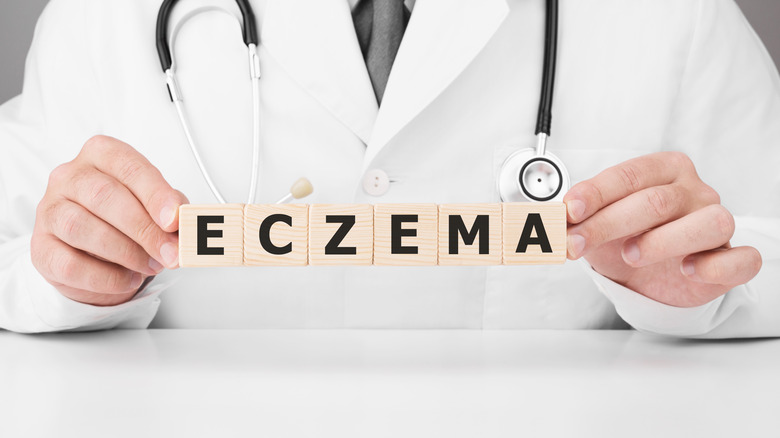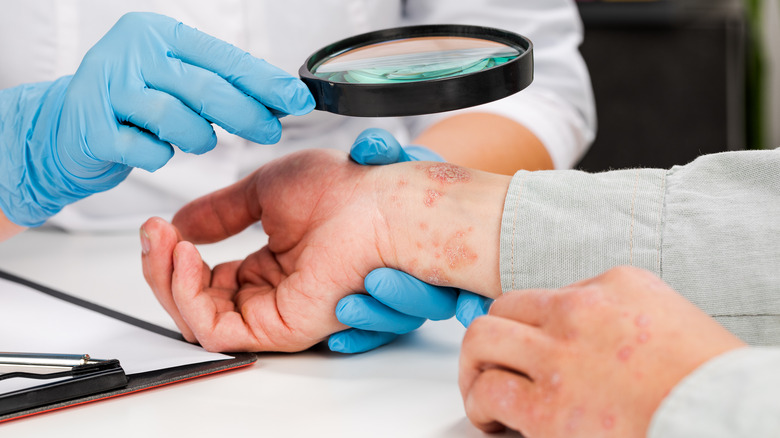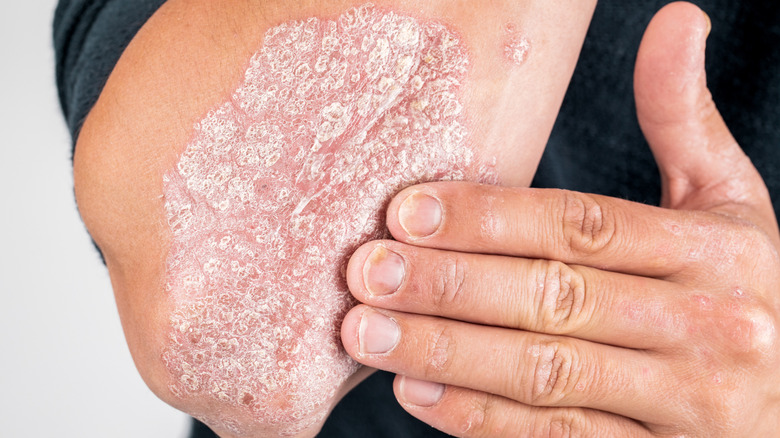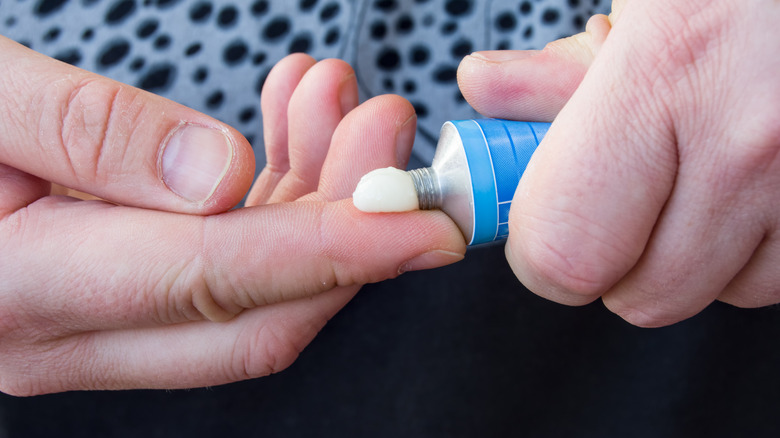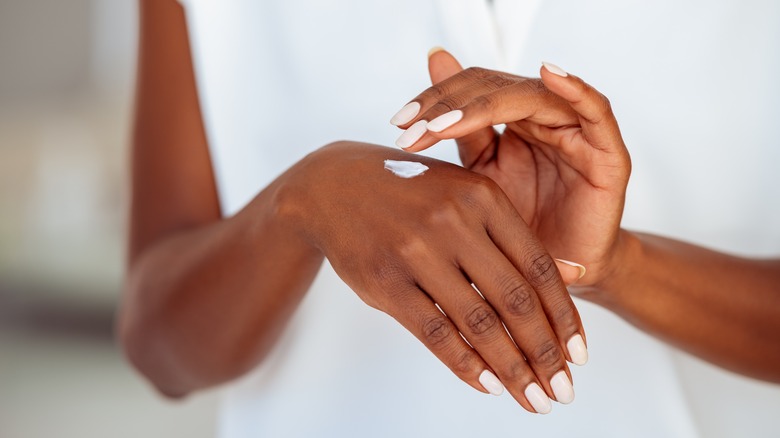The Different Types Of Eczema
The National Eczema Association writes that eczema is an inflammatory skin condition caused by an interaction between your genes and an irritant or allergen in your environment. When you are exposed to that substance, your immune system is activated and your skin becomes inflamed. Eczema can also be linked to mental health struggles, with stress being known to trigger or exacerbate its symptoms. It also tends to come in periodic flares, according to the Mayo Clinic.
Eczema is very common, according to the Cleveland Clinic. They say that it affects up to 15 million people in the United States alone. It tends to be quite prevalent among babies, with up to 20% having it. However, about half of affected infants will eventually grow out of it or have great improvement in their symptoms. It is also more common in people who have a history of allergies or asthma, either in themselves or in their family members. Both women and men can have eczema; however, women and African Americans are at higher risk.
There are seven common types of eczema that people may have. These types vary somewhat based on their specific triggers and symptoms.
7 Common Types of Eczema
According to Verywell Health, atopic dermatitis is the most common type of eczema and often starts in childhood. It is frequently found in people with a history of hay fever or asthma.
Contact dermatitis occurs when your skin comes in contact with something that is irritating or that you are allergic to. Reactions to poison ivy and nickel are two common types, according to the Cleveland Clinic.
Dyshidrotic dermatitis occurs on the hands and feet. It is not known exactly what causes it, but it can be related to excessive sweating, fungal infection, allergic reactions, atopic dermatitis, or intravenous immunoglobulin therapy.
Neurodermatitis is frequently caused by stress. It is characterized by dry, leathery, thick, itchy skin that can occur anywhere on the body. It can cause hair loss when found on the scalp.
Nummular dermatitis consists of distinctive coin-shaped patches of itchy skin, usually on the arms and legs, although it can be on the body, hands, or feet as well. Its appearance can lead to a misdiagnosis of psoriasis or ringworm. Its causes are unknown.
Seborrheic dermatitis is caused specifically by a reaction to Malassezia yeast. It most often occurs during stressful periods or in dry, cold climates.
Finally, stasis dermatitis is related to poor blood circulation. It mainly appears on the lower legs of older people with chronic venous insufficiency and venous hypertension.
Symptoms
The American College of Allergy, Asthma, and Immunology writes that eczema symptoms can include a red rash or red patches of skin, along with dry skin and itching. Affected skin can sometimes crack or bleed.
They say that the location of eczema can change throughout a person's life. Babies and younger children may have rashes on their cheeks or outside of the knees or elbows. Older children and adults, however, usually have them on their hands, feet, arms, or the backs of their knees.
They further note that eczema rashes can have painful blisters or cause changes in skin color. The itching associated with eczema flares can often be quite intense, leading people to scratch and sometimes develop skin infections.
While all types of eczema have certain symptoms in common, particular types of eczema may have symptoms that are unique to that type, according to Healthline. For example, nummular eczema is characterized by its round shape.
Causes
Healthline explains that the causes of eczema are not fully understood. However, scientists believe that it's due to an overactive immune system. Whenever your skin is exposed to some sort of irritant, like a chemical or an allergen, it could cause your immune system to respond too strongly, leading to the symptoms that we recognize as eczema.
One substance that has been implicated as being involved in eczema is a protein called filaggrin (filament aggregating protein). Filaggrin helps the skin form a better barrier against water loss so it remains moisturized. It also helps prevent the invasion of allergens and disease-causing organisms like viruses and bacteria. Unfortunately, this important protein has been found to be impaired in over half of the people who have eczema, according to the National Eczema Society. Having a weakened skin barrier could be the reason that these people's immune systems are being so easily triggered.
Having eczema could be due to a genetic mutation that causes faulty filaggrin production. The gene that codes for filaggrin is defective in about 10% of people. In addition, it is malfunctioning in over 50% of people who have atopic dermatitis, the most common form of eczema.
Treatments
The Mayo Clinic says that eczema is an incurable, chronic condition. According to WebMD, eczema treatments are generally aimed at controlling symptoms, healing the skin, preventing infections, and keeping future flares at bay.
Several prescription and over-the-counter medications may be used for these purposes. The National Eczema Association (NEA) lists JAK inhibitors, calcineurin inhibitors, PDE4 inhibitors, and steroids as prescription medications for the treatment of eczema. These topical treatments are aimed at managing the inflammation associated with this condition. People might also be prescribed an antibiotic in the event that they develop an infection, according to Healthline.
Over-the-counter medications which can be used to manage eczema symptoms include antihistamines, pain relievers, and hydrocortisone cream. Shampoos containing ketoconazole, selenium sulfide, coal tar, and zinc pyrithione are also available specifically for seborrheic dermatitis, according to NEA.
In addition, treatments like wet dressings; light therapy; counseling; and various relaxation, behavior modification, and biofeedback therapies may be helpful, according to the Mayo Clinic.
Preventing flares
Manhattan Dermatology advises that you should identify and avoid things that tend to trigger your symptoms. They note that certain things are common triggers, including wool and polyester, fragranced soaps, laundry detergent, aftershave, solvents like turpentine, and some household cleaners.
They also suggest wearing gloves to keep your hands from drying out, both in cold weather and when you are using cleaning products. They add, however, that you should give them an opportunity to dry off if they are sweaty. Sweat can also trigger flareups.
Another thing they recommend is practicing good bath and shower etiquette. You should keep your water warm rather than hot so it doesn't dry your skin, and limit your time bathing. Use unscented products. Also, after bathing, pat dry with a soft towel rather than rubbing. Finally, while your skin is still damp, apply moisturizer.
They further suggest moisturizing at least two times daily using fragrance-free products that are creamy and thick for the most protection from dryness.
The also advise doing what you can to reduce your stress. Stress is known to trigger or even exacerbate eczema flareups.
In addition to these steps, the American Academy of Dermatology states that bleach baths may be helpful in preventing flares. To prepare a bleach bath, add half of a cup of regular strength (6%) household bleach (not concentrated) to a full bathtub of lukewarm water. Soak from the neck down in the tub for whatever amount of time that your dermatologist recommends.

